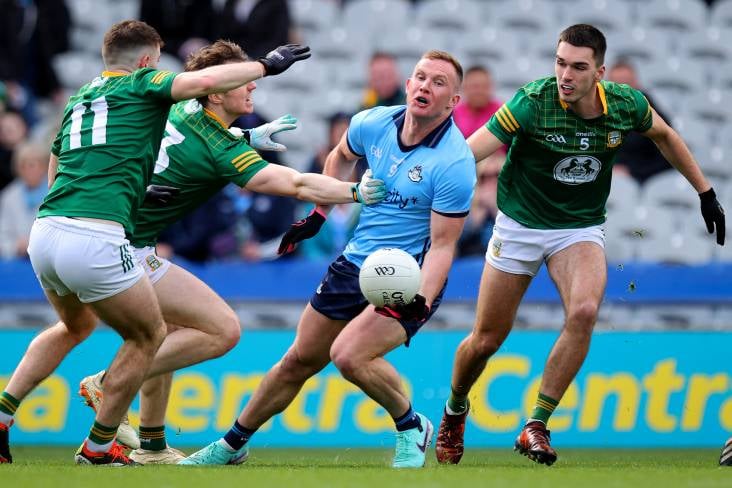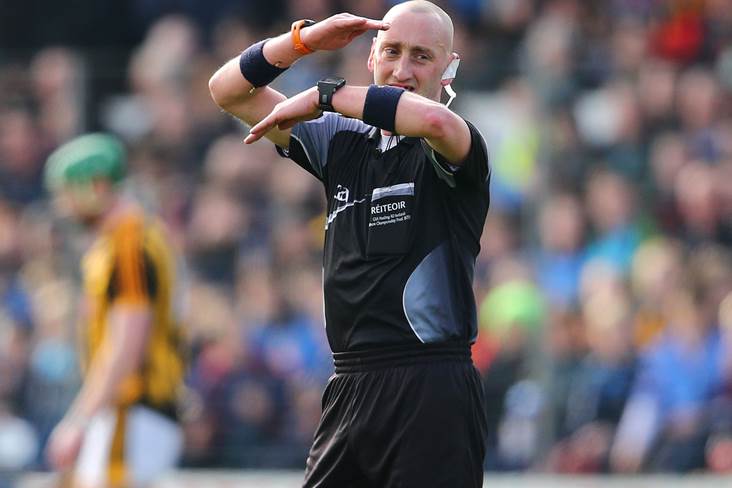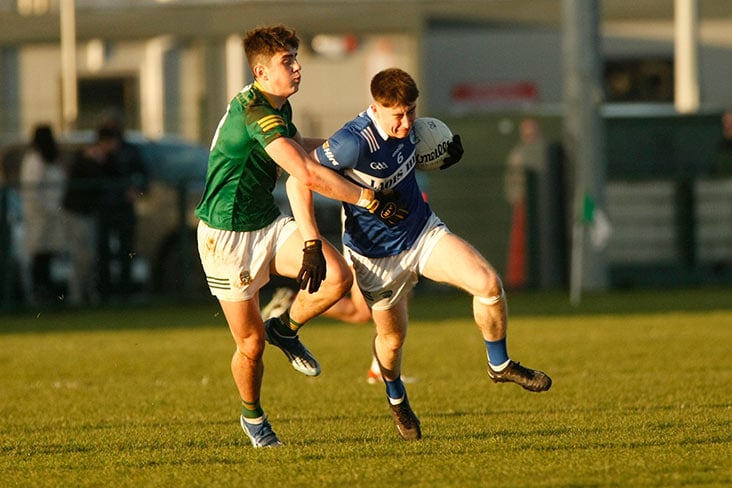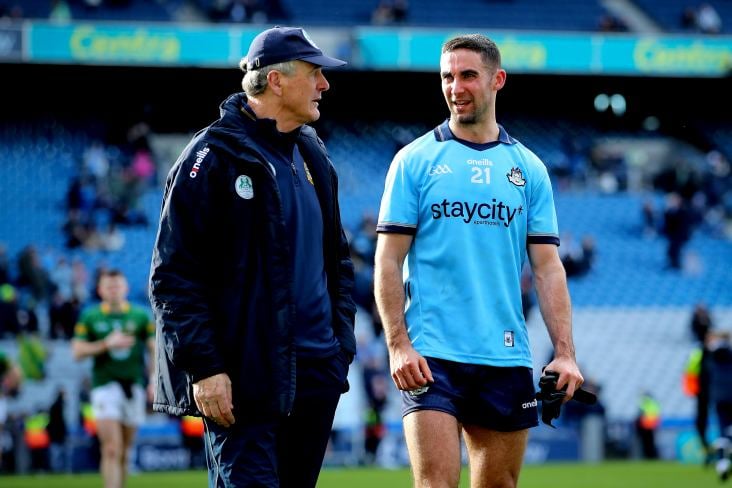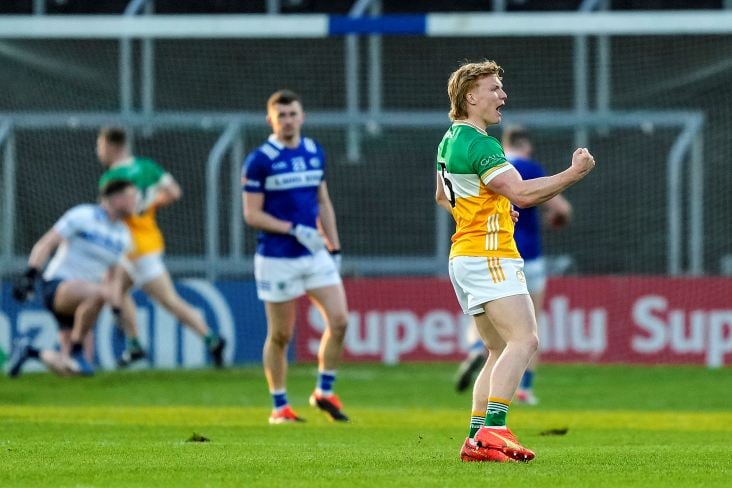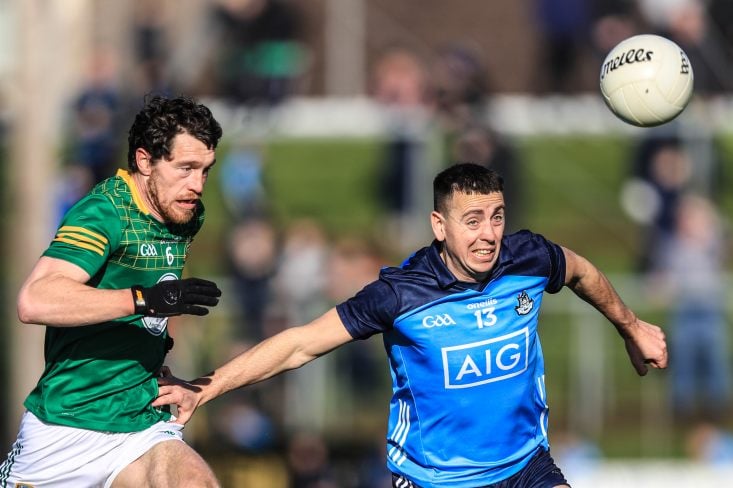Five proposed rule changes to be debated by Central Council today
November 24, 2018
Croke Park all lit up. INPHO/Morgan Treacy.
The GAA’s Central Council will meet today to determine the fate of the five proposed playing rules for experimentation in Gaelic football.
Following the initial publication of a number of playing rules proposals for experimentation on October 2, the GAA’s Standing Committee on the Playing Rules undertook a consultation process which involved senior intercounty football players, managers and referees as well as nine trial games.
The SCPR subsequently brought forward a number of playing rules for experimentation during the forthcoming season.
The plan is to trial them in the upcoming pre-season provincial tournaments and Allianz league - but all that will hinge on what Central Council delegates decide today.
Proposal 1: Hand Pass
Proposal for Experimentation (The Hand Pass): To introduce a restriction of three consecutive passes of the ball with the fist or open hand by players of the team in possession.
The playing of the ball by open hand(s) or fist for the purpose of scoring a point shall not be deemed a hand pass.
Penalty:
Free kick from where the foul occurred except as provided under the Exceptions in Rule 2.2.
Aim: To respond to the reported over use of the hand pass in Gaelic Football, a facet of the game that has grown exponentially over the last 8 seasons (Reference: Data provided to the SCPR by GaelicStats, 2018). This proposal also responds to views expressed by some GAA County Boards explicitly requesting action on this matter, when surveyed in July 2018 by the SCPR.
Rationale: (Independent data compiled by Rob Carroll- GaelicStats)
· Findings drawn from the analysis of 322 Senior intercounty Championship football games played between 2011 and 2018.
· During this period there has been a very significant increase in the average number of hand passes undertaken in Gaelic football matches, amounting to over 100 hand passes per game (2011- average number = 251-v-2018 - average number = 359)
· Statistics arising from the analysis of 38 Senior Intercounty football games played in 2018 revealed a ratio of 3.4 hand passes attempted for every foot pass.
· In the 2018 All Ireland Final, 75% of all passes played were in the form of a handpass or fist pass.
Proposal 2: Sideline Kick
Proposal for Experimentation (Side-line Kick): The ball shall be played forward from the kick except where the kick is inside the 20m line of the opposing team.
Penalty:
Cancel side-line kick. Throw-in the ball in accordance with Rule 2.2 Exception (v)
Aim: To generate more contested possessions, to encourage the ball to be returned to play quickly and to further initiate offensive play
Rationale: (Independent data compiled by the GAA’s Player, Club and Games Administration Department and made available to the SCPR 2018)
· Of a random sample of 10 games analyzed during the 2018 Senior All Ireland Football Championship the following outcomes from side line kicks were recorded. (Incidentally, by way of statistical comparison, some 21% of all frees awarded were played backwards by the player in possession of the ball). In the 10 games analyzed, however,:
· Overall 44% of all side-line kicks went backwards.
· 52% of side-line kicks awarded in the defensive half of the field went backwards.
· 36% of side-line kicks awarded in the attacking half of the field went backwards.
Proposal 3: The Advanced Mark
Proposal for Experimentation (The Advanced Mark): To extend the application of the Mark to the clean catching of the ball inside a 45m line from a kick in play (i.e. not from set-play) delivered by an attacking player on or beyond the opposing team’s 45m line, that travels a minimum of
20 metres and without it touching the ground.
The application of the Mark shall be standardised as follows:
Fifteen seconds shall be allowed for a Free to be taken from a Mark.
If the Referee determines that the player who makes the Mark has been injured in the process and unable to take the kick, the Referee shall direct the player’s nearest team mate to take the kick, but this may only be allowed in exceptional circumstances.
A player shall signify he is taking a Mark by immediately raising an arm upright.
A player that ‘plays on’ may be challenged/tackled.
A score may be made from a free awarded for a Mark in all cases.
In the case of a Mark being awarded to an attacking player on or inside the 13m line, the free, if availed of, shall be taken from the point on the 13m line directly in line with where the Mark is awarded.
In the case of a Mark being awarded to a defending player on or inside the 13m line, the free kick, if availed of, shall be taken from the point where the Mark is awarded.
The normal Rules governing free-kicks shall apply (e.g. players being 13m from the ball before it is kicked).
Exception:
A free-kick from a Mark shall be taken from the hand(s) only.
Aim: To further incentivize and reward the core skills of Gaelic football i.e. catching and kicking of the football; the kicking of the football in a forward direction and of a distance spanning minimally 20 metres; the clean catching of possession by both attackers and defenders; creative and innovative play; and the transfer of the ball into the offensive part of the field on a more consistent basis.
Rationale (Independent data compiled by Rob Carroll- GaelicStats)
· All available evidence clearly demonstrates that the current ‘Mark’ has facilitated clean catching of the football to a greater extent than was the case prior to its introduction.
· At the same time, the average number of kick passes per game has fallen by almost 15% (latest available figures from 2017) over the course of just 7 seasons (i.e. 127 foot passes witnessed per Senior intercountry game in 2011-v-110 foot passes played during such games in 2017). All other things remaining constant, the number of actual kick passes in intercounty Gaelic football will, based on this predictive trend, fall into double figures in fewer than five seasons (i.e. by 2023).
Proposal 4: Sin-Bin
Proposal for Experimentation (Sin-Bin): To have a Penalty on the day for a Black Card Infraction by ordering off the offending player for ten minutes in a Sin Bin.
The 10 minutes shall commence with the ordering off to the sin-bin and shall end on the expiry of the 10 minutes, irrespective of delays.
The 10 minutes shall be monitored by the 4th Official, where operating, and otherwise by the Referee.
The player may only re-join the game at a break in play and on the instruction of the 4th Official or Referee.
A subsequent Black Card Infraction shall be penalised by the showing of a Black Card followed by a Red Card.
In this case there shall be no substitution allowed.
The maximum number of substitutions in normal time to return to five.
The duties of a Referee and Sideline Official to be amended in accordance with the main Proposal.
Aim: To reduce the reported increase in cynical play/fouling and implement a penalty which encourages behavioral change, as the introduction of the sin-bin will give rise to an immediate material disadvantage for the team that has a player ‘sin binned’. A corollary of this- and perhaps why this proposal was widely supported by players surveyed on these experimental rules during October 2018- is that the player who receives a black card is permitted to return to the field of play after 10 minutes. For players who, perhaps upon considered review, may have been harshly awarded a black card in the first instance, this experimental proposal does offer some form of redemption.
Rationale (Independent data compiled by the GAA’s Player, Club and Games Administration Department and made available to the SCPR)
· The current assessment suggests that the Black Card is having a positive impact upon the game but greater consistency in its usage is required.
· It is proposed that the introduction of the Sin-Bin would assist with further behavioural change and discourage an increase in foul play as its availability as a sanction presents the real possibility of a team being reduced to 14 players on (potentially) a number of occasions during the course of a game.
·During the course of the 2018 Senior intercounty season (Allianz Leagues and All Ireland Championship) there was the equivalent of 0.87 black cards issued per game by the match referee. It is reasonable to conclude therefore that, at least during the course of the experimental phase, there may be no more than 1 sin binning per game (albeit, inevitably, it is possible there may be a slight increase in the use of the Black Card as the sanction following its deployment has now changed)
Proposal 5: Kick-Out
Proposal for Experimentation (Kick-Out): The kick-out shall be taken off the ground from a point on the part of the 20 m line that forms the semi-circular arc.
The ball shall not be played by a defending player until the ball has crossed the 45m line (nearest the kick-out point) or is played by an opposing player.
All players, other than the Goalkeeper (and another player if the goalkeeper is not taking the kick-out) shall be outside the 20m line, outside the arc and 13m from the ball until it has been kicked.
Penalties:
For another player on the team taking a kick-out to play the ball before it has crossed the 45m line (nearest the kick-out point) or has been played by an opposing player.
Penalty:
(i) Cancel kick-out
(ii) Throw in the ball on defenders’ 20m line in front of the scoring space.
For an opposing player not being outside the 20m line, outside the arc and 13m from the ball when it is kicked.
Penalty:
Free kick 13m more advantageous than place of original kick-out.
For another player on the team taking a kick-out not being outside the 20m line, outside the arc and 13m from the ball until it has been kicked.
Penalty:
(i) Cancel kick-out
(ii) Throw-in the ball on defenders’ 20m line in front of the scoring space
Aim: To encourage teams to kick the ball further up the field from the kick out when compared to the current practice employed by many teams whereby kick outs are played the minimum distance of 13 metres, which is affirming the possession style game that is off-putting for some spectators. The more rapid transfer of the ball into a contested part of the field may also discourage teams from employing a ‘blanket defense’ tactic as it will be increasingly difficult to establish certainty around which team will claim possession from the kick out. It will further present opportunities for the skill of clean catching and the deployment of the Mark, where it is accepted, to be demonstrated.
Rationale (Independent data compiled by Rob Carroll- GaelicStats)
· More recent data from the 2018 season, indicates a very significant decline in kick-outs crossing the 45m line. Indeed, the incidences of this in intercounty football has dropped by almost 40% in only eight seasons, whilst the number of short kick outs has grown by close to 400% over the same period.
Tweet
